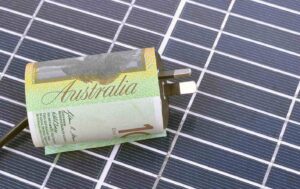So you’ve heard about hot-water heat pumps.
And now you want to buy one to replace your inefficient, costly-to-operate, and high green-house gas impacting electric-resistive or gas-burning hot water service.
Or it’s an emergency! Your old water service has just died and you need one as soon as possible. The shouting from the family is getting louder! What to do?
In Australia, hot-water heat pumps have been around for a while. I’ve seen some still operating that were installed in 2008, fifteen years ago. But this technology is only now going “mainstream” as folks electrify their homes and say good-bye to the gas bill.
And also, because of the lower climate impact of heat pumps, Australian federal, state, and territory governments have made a number of rebates and credits available which make buying a hot-water heat pump attractive versus other water-heating equipment.
So you’re thinking of getting one. But how does one go about it? Hopefully this article and the hyper-linked references will help.
69 brands – which is best, which are good?
For many people a hot-water heat pump is a new animal. There are 69 brands and 420 different models out there, according to the Clean Energy Regulator!
Which are good, which aren’t so good?
What size tank do you need?
Should the tank be made of stainless or enamelled steel?
Can you be able to run it with a timer off your rooftop solar-PV panels?
What’s the cost after rebates? Which rebates are you eligible for anyway – are they means tested? With Brand X, will the water be hot enough on a cold winter day in Ballarat?
Will we run out of hot water after four showers? You say it uses a refrigerant? Why would a water heater use a refrigerant?
You want hot water, not cold beer!
And most importantly, who you gonna call… to get a hot water heat pump?
How many horse power is your heat pump?
When I meet with clients to help them electrify and improve the comfort of their homes, a hot-water heat pump is just one of over a dozen topics they may want to discuss.
The conversations I’ve had make me think, is this what it was like to buy a car in 1910? Many people would have been interested in buying a car in 1910 as they started to see their neighbours drive down the street.
But what sort of car should one get? Even in 1910 there were many brands to choose from: a Cadillac Model 30, a Duesenberg Model A, or a good old Ford Model T? 3.6 litre engine or 4.8?
Was a forty mile-per-hour top speed fast enough? What safety features were there? Does it come with a horn?
Beyond knowing they had four wheels, what did the average person know about cars in 1910? They may have had an uncle that had one, but his Packard left him on the side of the road once. Or the farmer down the lane said “they’re all crap”, so why get rid of the horse and cart?
Will you sleep easy after your purchase?
But on the other hand, buying a heat pump isn’t like buying a car at all. A car can be an emotional purchase. Your identity might be linked to the car you buy. The neighbours will see your car, as will your sister-in-law. Status! Sadly, hot-water heat pumps aren’t seen as status symbols. (Readers, please let me know if I’m wrong about this.) In the end, most people just want to turn on the shower and feel the steamy hot water come out.
So perhaps buying a heat pump is more like buying a mattress. Do you really care what’s in your mattress, how it was made, where it came from? Or do you simply want to go to a reputable shop, lie down, feel how comfortable the mattress is, know what it’s going to cost, and get a knowledgeable answer to the question of “how long will it last”? And maybe also “how will it be recycled when it reaches its end of life?”
Maybe hot-water heat pumps are more like mattresses.
But enough with the analogies. If you want to buy a heat pump, but something is slowing you down from taking the next step, I hope this article will assist.
Or – not yet sold on a heat pump?
Hot-water heat pumps can be an excellent way to provide cheap hot water because as air-to-water heat pumps, they extract free renewable heat from the thin air outside your house. Yes, some electricity is used to power a heat pump (electricity which may or may not come from renewable sources), but the bulk of the energy a heat pump puts into your water is free renewable heat it extracts from the air.
Since free heat is free, this makes hot-water heat pumps probably the cheapest way to heat your water: costing as little as one-third the operating cost of burning gas and one-quarter the cost of using a kettle-like electric-resistive heater.
Even better, if you have solar-PV panels on your roof and if you manage to set your heat pump on a timer to use the electricity generated on your roof mid-day, your hot water will cost a lot less. It might be the cheapest hot water in the world.
But for those readers who aren’t yet sold on hot-water heat pumps (or might not have the space available for one), and who would like more information about all water heating options:
· here is a link to an article I wrote in 2021 for Renew Economy;
· here is a recent discussion by Choice on gas-fired versus heat pump water heating;
· or you could watch this 2019 presentation I did at the University of Melbourne that has been viewed by 18,000 people at the Renew YouTube channel;
· or check out this 2020 efficient hot water buyer’s guide from Renew Magazine;
· or check government websites such as from Sustainability Victoria.
And of course we post and comment about heat pumps every day at My Efficient Electric Home, including this poll of our 100,000 members that asked which hot-water heat pump brands they’ve been happy with.
Disclaimer
I’ve tried to provide accurate (yet inevitably incomplete) information and references in this article. Please consider this article to be only a guide. Use what I have written to work out the questions you will ask heat pump suppliers. Please don’t use this article alone to make a final purchase decision.
$33 or $8,000?
If you’ve been looking into heat pumps, you may have seen prices ranging from $33 to $8,000. How can this be? We’d live in a pretty crazy world if one mattress in the store cost 240 times more than another. So what’s going on with heat pumps?
Rebates and Credits
Because of the lower climate / greenhouse impact of heat pumps, Australian federal, state, and territory governments have made a number of rebates and credits available. These make buying a hot-water heat pump attractive versus other water-heating equipment.
Anyone who purchases a hot water heat pump will see the price has been reduced by a few hundred dollars because of federally-mandated renewable energy credits that go by the phrase “small-scale technology certificate”, or STCs. See below for more on the STCs.
On top of that, individual states may offer rebates. Victoria, for example, offers a means-tested $1,000 rebate under the Solar Homes program.
Victoria also then offers a not-means-tested rebate that may be worth a couple of hundred dollars under the Victorian Energy Upgrades (VEU) scheme should you purchase from an accredited installer.
SwitchedOn has also compiled a list of rebates available that are currently available around the country to help purchase efficient electric appliances.
This Australian government website may provide a link to rebates in your location, but check alsoyour own state or territory and local council government websites, conservation organisations, and community information sources.
And then beware of heat pump deals that look too good to true.
If it looks too good to be true
Because of the government credit and rebate schemes, some heat pump suppliers have sought to deliver a low-cost product that they can legally sell for not much more than the value of the credits.This is why we have seen advertisements for $499 heat pumps, $33 heat pumps, or even “free heat
pumps”.
Are these deals too good to be true? In order that you don’t end up disappointed, I list below some ofthe many things you can consider when buying a heat pump. Have your eyes open.
We do want our hot water to be reliable and don’t want to install “junk” that leaves us fuming in a cold shower at six o’clock on Christmas morning. Further, we don’t want to find that buying the “junk” has used up all the rebates you’re eligible for, leaving you to pay full cost to upgrade to a better system.
It starts with the refrigerant
The capabilities of heat pumps can be graded by the refrigerant used. This lies at the heart of what you’ll pay to own one.
In order of highest to lowest energy efficiency (lowest energy cost) and best capabilities, below I describe heat pumps that use the refrigerants that go by the code names of R744, R290, and R134a.(If you happen to stumble upon someone still selling a heat pump using R410a, perhaps give that a miss as it’s not common and seems to be undergoing imminent phase-out.)
No energy star ratings, but STCs
However, before I start to compare brands, be aware that unlike air conditioners or refrigerators, there is no government-regulated energy star-rating system for hot-water heat pumps. I don’t know why not – someone has been slack. Maybe someday.
But what we can use to compare energy efficiency among brands are the small-scale technology renewable energy credits, the so-called “STCs”. The Australian government recognises that hot-water heat pumps are able to provide relatively cheap hot water because they extract free renewable heat from thin air.
So, the same as when you buy electricity-generating solar-PV panels, you are rewarded by the Australian government for your heat pump purchase.
This will reduce the purchase cost by a few hundred dollars. When you get a quote for a hot-water heat pump, you will see the full price before the renewable energy credits (the STCs) are applied, and then you’ll see what the reduced price will be when you sign these STCs over to the vendor.
The number of STCs that can legally be applied to a given model of heat pump has been determined by a government-regulated process. Brands / models that are more efficient will attract more STCs than a less efficient brand.
Therefore, if you want some way to compare make/model efficiency, check out the number of STCs that will be applied.
For example, at the Clean Energy Regulator website we can see a 250 litre Sanden (using R744refrigerant) attracts 35 STCs in Climate Zone 5 while a similar size Quantum (using R290 refrigerant)attracts 32 STCs, and a Chromagen brand (using R134a refrigerant) attracts only 28 STCs. This mightnot seem like a big difference, but it’s the only regulated way we have to judge heat pump efficiency.
Brands using high pressure R744 (CO 2 ) refrigerant – capable and pricey
It can generally be said that the hot-water heat pumps that use carbon dioxide refrigerant (aka CO 2 aka R744) are the most capable, and it follows, the most expensive. These include the “split-system”arranged brands Sanden, Reclaim, Thermann X, et.al., with the heat pump part made in Japan and possibly the tank made in Australia.
Purchase and installation costs for this top class of heat pumps, even after rebates and credits, seem to be tracking at five to eight thousand dollars, depending on where you are in Australia and on what rebates and credits can be applied. Probably the weak Australian dollar is not helping us.
Carbon dioxide is a very useful refrigerant, but it’s expensive to deal with. The pressure rating of the pipework and compressor within a CO 2 heat pump is high, translating to higher purchase cost. So why bother with such high pressure?
The CO 2 -using heat pumps are the most efficient, don’t need a back-up electric-resistive element (and therefore don’t come with one), have a quick re-heat rate, and can successfully heat water under outdoor ambient temperature as cold as minus 15 deg C.
These heat pumps have been built to be used in places far colder than what is experienced in most Australian
climate zones.
All hot-water heat pumps create some noise because they have moving parts; a fan and a compressor; just like an air conditioner. However, the fans in this class of heat pump are generally large, operate at a lower speed and are therefore relatively quiet. If the heat pump part of a “split system” can be placed low to the ground, this can help to reduce noise further.
Brands using R290 (propane) refrigerant – middle range cost and good enough?
Generally, the brands that use R290 refrigerant (propane) have capabilities and prices in-between the R744 brands and the R134a brands. Brands with models using R290 refrigerant can include Quantum, Hydrotherm, Aquatech, and more.
Brands using R134a (1,1,1,2-tetrafluoroethane) refrigerant – on the cheaper end
Looking for the lower-priced heat pumps? These use R134a refrigerant, the hydrofluorocarbon (HFC)1,1,1,2-tetrafluoroethane, which is the same refrigerant used in the air conditioning systems of many of our automobiles.
Brands using R134a can include iStore, Stiebel Eltron, Chromagen, and more.
I wrote that the R744-using heat pumps may be rated to operate at temperatures as low as minus15 deg C. Some R134a heat pumps will work best if you don’t ask them to turn on when it’s colder than 5 deg C outside. But for example, where I live in Melbourne, is this constraint a problem?
Probably not. Often a householder will set their heat pump to come on mid-day when there is cheap solar-PV-generated electricity available, and you see, it’s not often (or ever) colder than 5 deg C mid-day in Melbourne. So, in that way you could say R134a heat pumps might be a good fit for Melbourne and similar climates, if this were the only important thing to consider.
If you did want to heat water with an R134a heat pump when it’s, say, zero deg C outside in Ballarat, you could still do that, but the device may switch to use its electric-resistive element in that situation in which case one loses the efficiency of the heat pump and it’s back to heating with an electric element similar to your kitchen kettle.
How critical is it to have a top efficiency heat pump anyway?
If your household uses only a small amount of hot water because it has few occupants, they all take short showers, and your shower heads are at least three-star rated using less than nine litres per minute of water, installing the best performing / most expensive hot-water heat pump might be difficult to justify economically or even with an eye on climate impacts.
Further, should you have solar-PV panels on your roof, you will likely want to time your heat pump to turn on mid-day and use the electricity you generate on your roof, because you probably aren’t being paid a high feed-in tariff for selling that electricity into the grid. When you do this, your heat pump becomes a “thermal battery”.
With this arrangement, this is very cheap hot water generated with low greenhouse gas emissions regardless of which brand of hot-water heat pump you have. One might ask, is owning the highest efficiency heat pump that critical?
But when buying a heat pump, as I listed above, there can be a lot more things to consider than just efficiency and operating cost. One of these things is refrigerant global warming potential.
Refrigerant global warming potential
Since many of us writing and reading this article are here largely because of the Climate Emergency, we should pay attention to the Global Warming Potential (GWP) of the gaseous refrigerants used.Ideally, harmful refrigerants are never lost to our atmosphere over the life of the heat pump but rather are collected and destroyed as a step in the thoughtful recycling of the equipment. But stuff happens.
As it happens, the most expensive-to-buy heat pumps have the least global warming potential in the event of refrigerant loss.
· R744 (CO 2 ) refrigerant has a GWP value of one, by definition, since it’s CO 2 .
· R290 (propane) refrigerant has a GWP of four.
· Compare those with R314a which has a massive GWP of 1,430.
And R410a, should you come upon a hot water heat pump with that, has a GWP even higher at 2,088.
So what?
What this can mean is you may have opted not to buy a gas-fired hot water heater because that would have resulted in ten tonnes of greenhouse gas (CO 2 -equivalent) being released into our atmosphere over ten years.
Instead, you were attracted to a heat pump that might result in only four tonnes of greenhouse gas being released (or far less and trending toward zero if your electricity supply is largely from renewables). But if your heat pump contains, say, 800 grams of R134a refrigerant, and through amishap or poor management that gas is released, this has the impact of adding the equivalent of one more tonne of greenhouse gas to our atmosphere.
Someday in Australia we may see refrigerants with such high global warming potential being phased out of new equipment purchases, similar to the way that ozone-destroying refrigerants have been phased out.
There’s more! For further details, please read the rest of the article on our sub-site focused on electrification, SwitchedOn, where you can find more stories about electrifying the home, and your transport.










